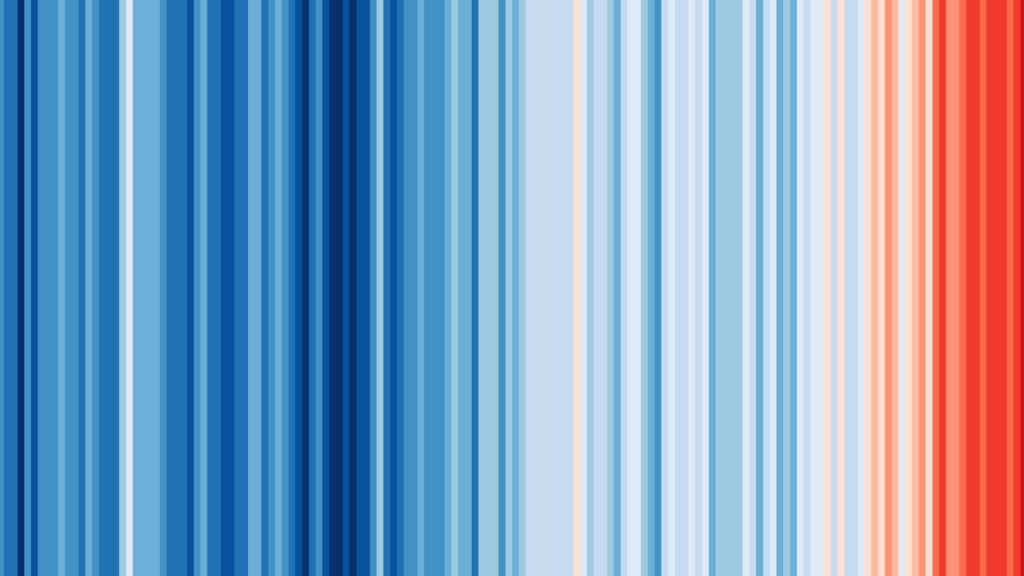
What is climate change?
Climate change is a shift in the average climate over a long period of time.
Today, our climate is changing rapidly, driven by human activities. The average temperature of the planet has risen by around 1.2°C since the industrial revolution and the last ten years was the warmest decade ever recorded.
Temperatures are rising even faster over land. In fact, temperatures over land surface have risen by around 1.5°C since the industrial revolution.
We are seeing changes that have never been seen before. The atmosphere and ocean have warmed, the amount of snow and ice have diminished, and sea levels have risen.
We know this because scientists collect climate data all over the world every day. They also study materials that have been around for hundreds or thousands of years, like inside trees or ice cores, to find out how the climate has changed over a longer period of time.
To visualise the changes we’re seeing, Professor Ed Hawkins from the National Centre for Atmospheric Science and University of Reading created a set of warming stripes that illustrate how global temperatures have changed over the last 150 years.

These are known as Warming Stripes. Each stripe represents one year, and the colour of the stripe represents the average temperature for that year. Blue stripes indicate colder years. Red stripes indicate warmer years. You can see how global temperatures have changed over time.
To stop climate change, we need to reduce the amount of greenhouse gases emissions being released by human activities around the world. Governments, businesses and individuals around the world can all contribute to this. In 2019, the UK became the world’s first major economy to commit to a target of ‘net zero’ emissions by 2050.
Causes of climate change
The dramatic rise in global temperatures is caused by human emissions of greenhouse gases into the atmosphere. This started in the 1800s when humans began to burn fossil fuels during the industrial revolution.
Greenhouse gases are gases that absorb heat energy. They act like a blanket wrapped around the earth, trapping some of the sun’s heat within our atmosphere. The more greenhouse gases in our atmosphere, the more heat is trapped. The levels of greenhouse gases in the atmosphere are unprecedented in at least the last 800,000 years.
Humans create greenhouse gases in many different ways. The biggest source is burning fossil fuels for electricity and heat, which accounts for around one quarter of human emissions. Agriculture, rearing animals and growing crops, also releases large amounts of greenhouse gases. Cement production is estimated to account for around 2% of global carbon dioxide emissions. And, deforestation contributes because trees help to capture and remove greenhouse gases.
The most common greenhouse gases are carbon dioxide, methane and ozone, water vapour, nitrous oxides and fluorinated gases.
Carbon dioxide is one of the most important greenhouse gases because there is a lot of it, and it lasts a long time in the atmosphere. It’s released by things like burning fossil fuels, cement production and deforestation.
The atmospheric concentration of carbon dioxide has increased by around 40% since the industrial revolution.
Another important greenhouse gas is methane. Methane absorbs more heat per molecule than other greenhouse gases, and is released from our agriculture and our landfills.
Climate is affected by natural processes such as changes in the sun’s radiation, Earth’s orbit around the sun, and volcanic eruptions. However, none of these changes account for the dramatic rise in global temperatures since the industrial revolution. They only have a very small effect.
The link between greenhouse gases and temperature was first identified in the nineteenth century. Soon after, scientists suggested that human activities were causing carbon dioxide concentrations in the atmosphere to increase.
In 1988, the United Nations and the World Meteorological Organisation established an international group of scientists to report on climate change. This was called the Intergovernmental Panel on Climate Change (IPCC).
To this day, the IPCC is responsible for assessing how the climate is changing and informing governments around the world.
Effects of climate change
Climate is vital to our lives – from our food production, transport and economy to our water, wildlife and health.
Rising temperatures are causing serious changes to our climate, there are serious consequences for future food security, water resources, health and biodiversity.
The world has warmed by around 1°C since the industrial revolution and is getting warmer at increasing pace. This phenomenon, known as global warming, is causing our climate to change.
Almost 90% of the extra heat trapped in our atmosphere by greenhouse gases is being absorbed by the oceans, and warmer atmosphere and oceans are causing steep declines in Arctic sea ice and increasing sea levels. You can imagine the effect this has on coastal communities and wildlife.
Our oceans have also absorbed around 30% of the carbon dioxide released since the industrial revolution, causing the water to turn more acidic. That’s bad news for most creatures that live in the ocean.
Extreme weather is becoming more frequent. Flooding, droughts, and forest fires have all become more frequent over the last few decades. Flooding and droughts often damage farmlands and infrastructure, while forest fires carry severe risk to our health.

Weather events are also becoming more frequent and more intense. For example, scientists believe the European heatwaves in 2019 would have been 1.5 to 3 ºC cooler in an unchanged climate. This type of extreme event poses a real risk, including heat-related illness and strain on our water supplies.
Some places may even become uninhabitable if food and water become scarce, meaning that thousands of people need to leave their homes and find somewhere else to live.
Scientists at the National Centre for Atmospheric Science are working to understand how the climate is changing, and how it will affect different parts of the world. This information helps governments, businesses and society to adapt and mitigate the effects of climate change.
